s- U06SectionA
(完整word版)物理化学基本概念
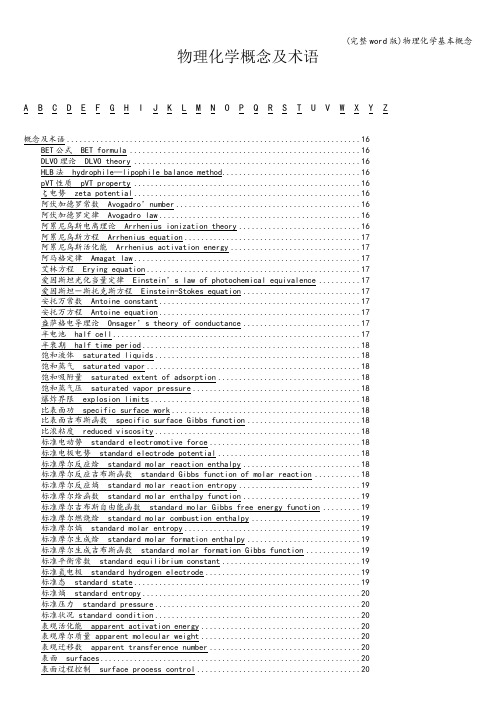
物理化学概念及术语A B C D E F G H I J K L M N O P Q R S T U V W X Y Z概念及术语 (16)BET公式BET formula (16)DLVO理论 DLVO theory (16)HLB法hydrophile—lipophile balance method (16)pVT性质 pVT property (16)ζ电势 zeta potential (16)阿伏加德罗常数 Avogadro’number (16)阿伏加德罗定律 Avogadro law (16)阿累尼乌斯电离理论Arrhenius ionization theory (16)阿累尼乌斯方程Arrhenius equation (17)阿累尼乌斯活化能 Arrhenius activation energy (17)阿马格定律 Amagat law (17)艾林方程 Erying equation (17)爱因斯坦光化当量定律 Einstein’s law of photochemical equivalence (17)爱因斯坦-斯托克斯方程 Einstein-Stokes equation (17)安托万常数 Antoine constant (17)安托万方程 Antoine equation (17)盎萨格电导理论Onsager’s theory of conductance (17)半电池half cell (17)半衰期half time period (18)饱和液体 saturated liquids (18)饱和蒸气 saturated vapor (18)饱和吸附量 saturated extent of adsorption (18)饱和蒸气压 saturated vapor pressure (18)爆炸界限 explosion limits (18)比表面功 specific surface work (18)比表面吉布斯函数 specific surface Gibbs function (18)比浓粘度 reduced viscosity (18)标准电动势 standard electromotive force (18)标准电极电势 standard electrode potential (18)标准摩尔反应焓 standard molar reaction enthalpy (18)标准摩尔反应吉布斯函数 standard Gibbs function of molar reaction (18)标准摩尔反应熵 standard molar reaction entropy (19)标准摩尔焓函数 standard molar enthalpy function (19)标准摩尔吉布斯自由能函数 standard molar Gibbs free energy function (19)标准摩尔燃烧焓 standard molar combustion enthalpy (19)标准摩尔熵 standard molar entropy (19)标准摩尔生成焓 standard molar formation enthalpy (19)标准摩尔生成吉布斯函数 standard molar formation Gibbs function (19)标准平衡常数 standard equilibrium constant (19)标准氢电极 standard hydrogen electrode (19)标准态 standard state (19)标准熵 standard entropy (20)标准压力 standard pressure (20)标准状况 standard condition (20)表观活化能apparent activation energy (20)表观摩尔质量 apparent molecular weight (20)表面活性剂surfactants (21)表面吸附量 surface excess (21)表面张力 surface tension (21)表面质量作用定律 surface mass action law (21)波义尔定律 Boyle law (21)波义尔温度 Boyle temperature (21)波义尔点 Boyle point (21)玻尔兹曼常数 Boltzmann constant (22)玻尔兹曼分布 Boltzmann distribution (22)玻尔兹曼公式 Boltzmann formula (22)玻尔兹曼熵定理 Boltzmann entropy theorem (22)泊Poise (22)不可逆过程 irreversible process (22)不可逆过程热力学thermodynamics of irreversible processes (22)不可逆相变化 irreversible phase change (22)布朗运动 brownian movement (22)查理定律 Charle's law (22)产率 yield (23)敞开系统 open system (23)超电势 over potential (23)沉降 sedimentation (23)沉降电势 sedimentation potential (23)沉降平衡 sedimentation equilibrium (23)触变 thixotropy (23)粗分散系统 thick disperse system (23)催化剂 catalyst (23)单分子层吸附理论 mono molecule layer adsorption (23)单分子反应 unimolecular reaction (23)单链反应 straight chain reactions (24)弹式量热计 bomb calorimeter (24)道尔顿定律 Dalton law (24)道尔顿分压定律 Dalton partial pressure law (24)德拜和法尔肯哈根效应Debye and Falkenhagen effect (24)德拜立方公式 Debye cubic formula (24)德拜-休克尔极限公式 Debye-Huckel’s limiting equation (24)等焓过程 isenthalpic process (24)等焓线isenthalpic line (24)等几率定理 theorem of equal probability (24)等温等容位Helmholtz free energy (25)等温等压位Gibbs free energy (25)等温方程 equation at constant temperature (25)低共熔点 eutectic point (25)低共熔混合物 eutectic mixture (25)低会溶点 lower consolute point (25)低熔冰盐合晶 cryohydric (26)第二类永动机 perpetual machine of the second kind (26)第三定律熵 Third—Law entropy (26)第一类永动机 perpetual machine of the first kind (26)缔合化学吸附 association chemical adsorption (26)电池常数 cell constant (26)电池电动势 electromotive force of cells (26)电池反应 cell reaction (27)电导 conductance (27)电导率 conductivity (27)电动势的温度系数 temperature coefficient of electromotive force (27)电化学极化 electrochemical polarization (27)电极电势 electrode potential (27)电极反应 reactions on the electrode (27)电极种类 type of electrodes (27)电解池 electrolytic cell (28)电量计 coulometer (28)电流效率current efficiency (28)电迁移 electro migration (28)电迁移率 electromobility (28)电渗 electroosmosis (28)电渗析 electrodialysis (28)电泳 electrophoresis (28)丁达尔效应 Dyndall effect (28)定容摩尔热容 molar heat capacity under constant volume (28)定容温度计 Constant voIume thermometer (28)定压摩尔热容 molar heat capacity under constant pressure (29)定压温度计 constant pressure thermometer (29)定域子系统 localized particle system (29)动力学方程kinetic equations (29)动力学控制 kinetics control (29)独立子系统 independent particle system (29)对比摩尔体积 reduced mole volume (29)对比体积 reduced volume (29)对比温度 reduced temperature (29)对比压力 reduced pressure (29)对称数 symmetry number (29)对行反应reversible reactions (29)对应状态原理 principle of corresponding state (29)多方过程polytropic process (30)多分子层吸附理论 adsorption theory of multi—molecular layers (30)二级反应second order reaction (30)二级相变second order phase change (30)法拉第常数 faraday constant (31)法拉第定律 Faraday’s law (31)反电动势back E。
优恩半导体瞬态抑制二极管SMBJ6.0A

优恩半导体瞬态抑制二极管SMBJ6.0A
优恩半导体(UN)
一、描述:
该SMAJ6.0CA是专门用于保护敏感电子因闪电和其他瞬态电压瞬变设备电压事件。
二、特征:
1、用于表面安装的应用程序,以优化电路板空间
2、低泄漏
3、单向和双向单元
4、玻璃钝化结
5、低电感
6、优良的钳位能力
7、600W峰值功率能力在10×1000μ波形重复率
(占空比):0.01%
8、快速响应时间:通常小于1.0ps从0伏特至VBR分钟
9、典型的IR小于5μ高于12V
10、高温焊接:260℃/40秒终端
11、典型最高温度系数ΔVBR=0.1%×VBR@25°C×ΔT
12、塑料包装有保险商实验室可燃性94V-0
13、雾锡无铅电镀
14、无卤素,符合RoHS标准
15、典型的故障模式是短距离过规定的电压或电流
16、晶须测试是根据每个其表JEDEC JESD201A进行
17、IEC-61000-4-2ESD的15kV(空气),8kV的(联系)
18、数据线,符合IEC61000-4-2üESD保护(IEC801-2)
19、数据线,符合IEC61000-4-4EFTü保护(IEC801-4)
三、应用:
TVS器件SMBJ6.0A主要用于保护I/O接口,VCC通讯总线和其他脆弱的电路,计算机,工业和消费电子应用。
lectureslides_U06summaryslides

• Derived distributions: Y = g (X ): find CDF of Y ; can go directly w UNIT 6: Further on her topics — topics Summary UNITon 6: r.v.’s Further topics on r.v.’s r.v.’s — — Summary Summary Y = aX + b: simple formula UNIT UNIT 6: 6: Further Further topics topics on on r.v.’s r.v.’s — — Summary Summary UNIT r.v.’s — Summary Z 6: = Further g (X, Y ): topics same on method, using PDFs ibutions: • Derived distributions: LECTURE 10 UNIT 6: distributions: Further topics on r.v.’s — • Derived •Y Derived distributions: Z Summary = X + Y g(X, Y independent): convolut = g ( X ): find CDF of Y ; can go directly when is monotonic nd CDF of Y ; can go directly when g is monotonic UNIT 6: Further topics on r.v.’s — Summary UNIT 6: Further topics on r.v.’s — Summary UNIT 6: Further topics ongo r.v.’s —when Summary • directly Derived distributions: Y = X ): CDF of g Y= =g g( ( X+ ): bfind find CDF formula of Y Y ;; can can go directly when g is is monotonic monotonic normal special case Y aX : simple simple formula • Derived distributions:ContinuousYBayes rule; = g (X ): find CDF of Y ; can go directly when g Y = aX + b : formula Y =g aX + b : simple simple formula Z = ( X, Y ): same method, using PDFs Derived distributions: Derived distributions: same•• method, using PDFs • Derived distributions: Y = g ( XY ): find CDF of Y using ;using can CDFs go when g is monotonic Derived distributions Y directly = aX + b : simple formula Z = g ( X, ): same method, Z = g ( X, Y ): same method, CDFs Z X + Yfind ( X, Y independent): convolution formula andusing mechanics; Y g ( ): CDF of ; formula can go directly g gis Y= = gX (g X ): find CDF ofY Y ; can go directly when ismonotonic monotonic (X, Y independent): convolution and mechanics; Y = (Y X find CDF of Y ; can directly when g is monotonic Y = aX + :( simple formula Zgo = g (X, Ywhen ): same method, CDFs Z X X, Y convolution formula and mechanics; Z= = X+ + Yb): ( X, Y independent): independent): convolution formula and mechanics; normal special case Y = aX + b : simple formula Y = aX + b : simple formula al case • Readings: ZPDFs = X + Y (X, Y independent): Z = (X, Y+ ): b same method, using Yg = aX : simple formula pZ (z ) =convolution pX (x) pYform (z normal special case normal special case x Z g ( ): same method, PDFs Z= = gX, ( X, Y ): same method, using PDFs Section 3.6; start Section 4.1 using normal special case Z = X + Y X, Y independent): convolution formula and mechanics; Z = g (Y X, Y( ): same method, using PDFs Z = X + Y Y convolution formula and mechanics; Zof = X + Y( (case X, Y independent): convolution formula and mechanics; normal special Z = X + YX, ( X, Yindependent): independent): convolution formula and mechanics; sum independent normals is sum of independent normals is normal normal ∞ normal sum of independent normals is normal normalspecial specialcase case p− z) ) = Review pf )) p= ) (x case Z (x X( Y (z − t (tz f )f (z − x) dx p normal (z ) = special p (x) p (z
浊点萃取钨丝电热蒸发原子荧光光谱分析法测定水样中的As(Ⅲ)和As(Ⅴ)
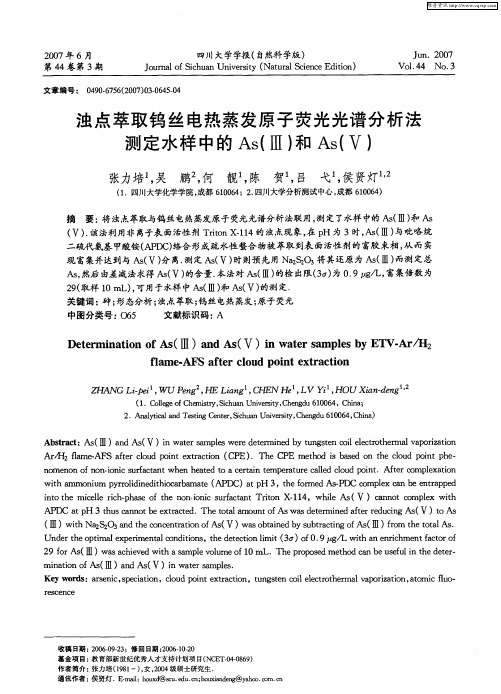
Un e e pi l x e me tl n io s te eet nl t( a o . / t r h n c r dr h t pr na c dt n , h tci mi 3 ) f 9飕 Lwi a e i me t at t o ma e i o i d o i 0 hn nc f oo f 2 r ( 9f m)Wa hee t mpe o me 0m Th rp sdmeh dC e sflntedtr oA s s a i d wi as l v l 1 L. e o e to b eu i ee— c v h a u o f p o n a u h
n m e o o -o i u fca twh nh ae e ti e eau ec l d c u it o n n o n n incs ra tn e e tdt acran tmp r tr al l dp n .Afe mp e ain f o e o o trc o lx t o
2 A a t a adT si e t ,i unUnvr t,h nd 10 4 C i ) . n l i l n et gC ne Sc a i sy C eg u6 0 6 , hn yc n r h ei a
Abtat A ( s c: s m)adA ( r n V)i ae mpe r eemie ytn s ncle c ohr l aoi t n s nw t s l weedtr ndb gt l l t temavprai ra s u e o e r z o
ISA2006-详细实例实验手册
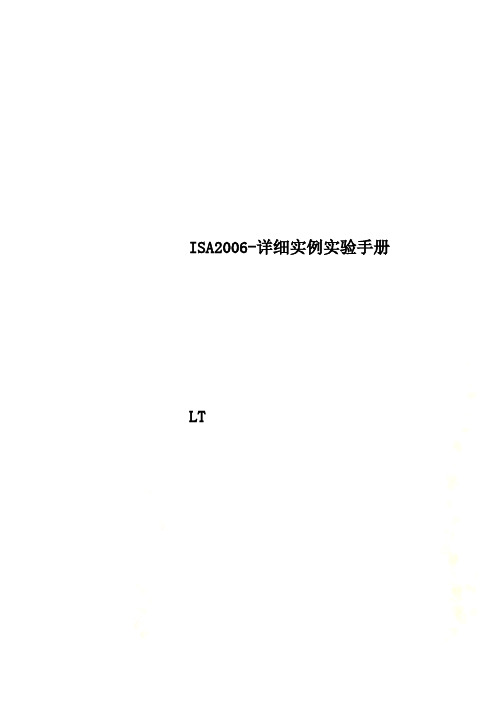
ISA2006-详细实例实验手册LT同意软件许可协议,选择下一步。
输入用户名,单位及序列号等参数后,来到安装类型界面,如下图所示,选择自定义安装。
选择ISA2006的安装组件,从下图可知,只有ISA服务器和ISA服务器管理两个组件。
有ISA2004经验的管理员要注意,ISA2004中的ISA客户端共享和消息筛选两个组件已经不再被支持,消息筛选被Forenfront取代,ISA客户端共享需要用手工共享的方法实现。
接下来设置内网的地址范围,点击“添加”按钮。
顺便提一下,这个参数很重要,因为在ISA中网络是防火墙策略中最基本的一个考虑因素,具体我们回头再说。
设置内网范围时,点击“添加适配器”,如下图所示,选择与内网相连的网卡,点击确定。
这里建议大家最好把ISA上的网卡根据实际连接情况命名为内网,外网,外围等,以方便后续使用。
根据我们提供的网卡,ISA将内网的地址范围设置为10.1.1.0-10.1.1.255,点击确定。
安装程序询问是否允许不加密的防火墙客户端连接。
不加密的防火墙客户端指的是ISA2000之前的防火墙客户端,ISA2000之后的防火墙客户端支持数据加密,安全性更好,由于在实验环境中不需要使用早期防火墙客户端,因此我们不用勾选“允许不加密的防火墙客户端连接”。
安装程序警告我们在安装过程中有些服务会重新启动,选择“下一步”。
完成了参数设置,终于开始安装了。
如下图所示,点击“完成”,结束了ISA2006的常规安装。
至此,我们完成了ISA2006的常规安装。
安装过程并不复杂,相信大家都可以完成,难的地方在后面的管理部分,慢慢来吧。
二ISA2006标准版的无人值守安装ISA2006的无人值守安装原理是很简单的,常规安装时我们通过交互方式输入安装参数,无人值守时只需事先将安装参数写到答案文件中,然后让ISA的安装程序从答案文件中获取参数就可以了。
因此我们实现ISA2006的无人值守只需要注意两点:1)如何创建答案文件2)如何让安装程序调用答案文件先解决第一个问题。
plugin-EE4214 Project Proposal
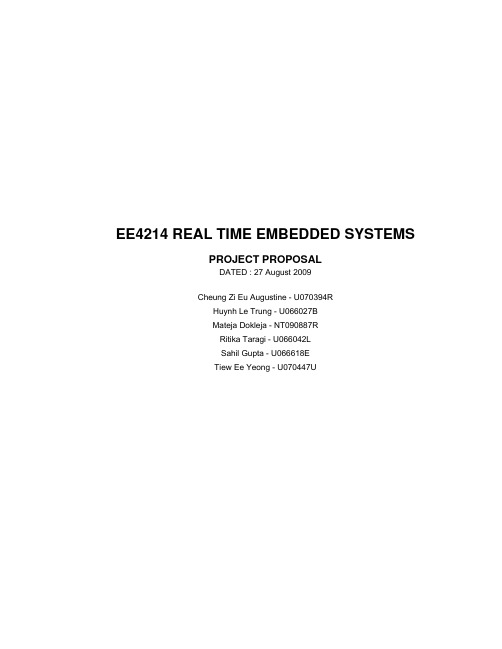
EE4214 REAL TIME EMBEDDED SYSTEMSPROJECT PROPOSALDATED : 27 August 2009Cheung Zi Eu Augustine - U070394RHuynh Le Trung - U066027BMateja Dokleja - NT090887RRitika Taragi - U066042LSahil Gupta - U066618ETiew Ee Yeong - U070447UContents1. PROJECT INTRODUCTION (2)1.1 OVERVIEW (2)1.2 DETAILED DESCRIPTION (2)1. 3 ADDITIONAL FEATURES (IF TIME PERMITS) (3)2. BLOCK DIAGRAM (4)2.1 Workflow (4)2.2 Dataflow (5)3. RESPONSIBILITIES AND TIMELINE (6)3.1 DESCRIPTION OF AREAS TO BE LEARNT: (6)3.2 TIMELINE (8)11.PR ODUCTIONOJECT INTR1.1 OVERVIEWHospitals and clinics provide essential and mandatory health care services to the people. Withthe growing volume of patients seeking medical attention everyday, it is imperative to have inplace a smooth functioning Service Management System to ensure highest standards ofserviceability. An inefficient system could lead to overcrowding of clinics, a strain on facilities,and inconvenience to patients, making health care more inaccessible and inequitable for thepopulation.For our project, we propose to develop a fair Clinic Queue Management System to allocatepatients to a well managed hospital Queue Management System.1.2 DETAILED DESCRIPTIONIn this section, we will describe the Queue Management System, its requirements and how the system work in real time.For this system, we assume that the ‘Clinic Queue Management System’ will have the following standard information:‐ No. of Doctors on duty, thereby the no. of Examination rooms‐ Treatment roomThe above rooms are all assigned a number for the sake of recognition and this information ismade available to the patients.Step 1: On entering the clinic, a patient will be requested to enter mandatory details into a user friendly interface system. The details include basic health information (such as weight, height), the kind of medical attention required (influenza, fracture, ear pain, pregnancy test, routinecheck‐up, etc), appointment number if any, or/and preference for Doctor (whether a Doctor has been treating a particular patient in the past).Step 2: Based on the entered information, the patient is then categorized and allotted into the following types:‐General Patient‐Patient with appointment‐Patient seeking specialist attention (e.g. an Eye Doctor)‐Patient seeking short routine check‐up or consultation2‐Emergency Case‐Patient requiring treatment (e.g. bandages)Step 3: The system uses certain pre‐stored data and the information entered on patient’s arrival to assign real time parameters such as Request time (r), Start time (s), Worst‐case Execution time (C), Absolute Deadline (d), Relative Deadline (D) and Finishing time (f).Step 4: Based on the above categorization, the patient is assigned to a queue.‐A General Patient is assigned to one of the general queues. The system will useScheduling algorithms (such as First Come First Served, Round Robin) to ensuremaximum probability (Best effort) of tasks meeting their deadlines.‐A patient with an appointment will automatically be placed in a queue depending on his start time and appointed doctor‐in‐charge.‐Patient seeking specialist attention (e.g. an Eye Doctor) will be allocated to the queueof the specialist.‐ For Patient seeking short routine check‐up or consultation, Scheduling Algorithms willbe used to check small tasks and applicability of the SJF Algorithm.‐In Emergency Cases, Scheduling Algorithms will be used to handle priority basedsituations. A deadline will be set for attendance to emergency cases.The system should also handle any delays arising due to extended consultation times and emergency cases by re‐examining each queue status and reallocating patients to different queues.Step 5: A Queue number will then be allotted to the patient. Details such as estimated time will also be generated. On his turn, a Display Screen is updated with his queue number and the room number he has to proceed to. It must be noted that Queue numbers are issued for easy reference with patients and they may not be in order.1. 3 ADDITIONAL FEATURES (IF TIME PERMITS)e of RFID cards to obtain basic patient informationB.Mobile System will text patients when it is their turn arrives, or even to allow them to accesscrowd information in the clinicC.Special protocol to handle Pandemics such as Swine Flu32. BLOCK DIAGRAM 2.1 WorkflowPatientTerminal 1PatientTerminal 2Determine category of patientInput,eg Laptop or Smart CardInput, eg Laptop or Smart CardControllerMain Display:Allocation of Consulting room or Test/Treatment roomProceed to Consulting Room (with patientnumber Display)Proceed to Test/Treatment room (with patient number display)Waiting time 2Waiting time 3Block DiagramWaiting time 1Terminals ‐ These are used to identify the patients, their history and current need.Determine the category of the patient ‐ With the data from the terminal, a category is assigned to the patient, eg general consultation, test, operation and emergency. Consultation and operation are available by appointment also.Controller ‐ Takes into account the category of the incoming patients and availability of the rooms to allocate new rooms.Main Display ‐ Receives information from the controller and displays the allocated room for patients along with their waiting time.Note ‐ Doctors might advise a patient to go to a test room after consultation. This might involve a waiting time. The consulting, test and operation rooms relay information back to the ontroller when they are done with a patient.c 42.2 Dataflow wWhen a person finishes entering his/her details, information will be passed to the uCsimm that is interfaced with the display screen. Notices (via the UI, for example) such as the Request time, r, how long he/she will have to wait at most to be served (deadline ‐ d or D), the expected waiting time (or the expected time to calculate the new queue number ‐ C) will be shown. Then the controller takes over and treats the new patient as a new “task” and tries (best effort) to put him into a queue so that other patients (tasks) in the same queue will not miss their deadlines. Priority handling will also occur where the controller fetch information from the database laptop and determines which patient would be served first. Emergency cases will be specially handled so their turns may come earlier (e.g. queue no. 3 for an emergency case may come before queue no. 10 for a normal case).53. RESPONSIBILITIES AND TIMELINE3.1 DESCRIPTION OF AREAS TO BE LEARNT:Ritika Taragi•Task Scheduling¾A thorough knowledge of the Scheduling Algorithms, its applicability and its constraints is needed to develop algorithms for different cases.¾The concept of Lateness and application in the system to ensure tasks meeting deadlines.•I/O User Interface¾Programming to develop the interface for entering and displaying information.Augustine•Sending information to display screen•Simulation of test case scenarios•Communication between multiple systemsHuynh Le Trung•Task scheduling¾To study about different scheduling algorithms and implement them in the project •Communication¾To study on how the uCsimm board can communicate with a host computer via the serial interface (to access the database when needed)Mateja Dokleja•I/O user interface¾Gain knowledge about concept of user friendly interface¾Learn about graphic display of information•Smartcard system¾Learn how to work with the smart card (reading, writing)6¾Learn about security possibilities of smart cards¾Do research on different kinds of smart cards and choose the one that is optimal for the system•Processing of input information¾Explore options of convenient formats of saving data for later use in the system¾Research how to work with information entered in the way that is medically accurateTiew Ee Yeong•Database¾Learn how to utilize our laptops to communicate with the controller and store patients’ information when necessary¾Learn how to pass massages between the kernel and user space when using the RTAI, such as the FIFO function since real time information needs to be processed•Simulation¾Explore on the various kind of patients that would visit a clinic and think of all possible scenarios that would need real time considerations¾Generate test cases and look for errorsSahil Gupta•System architect¾Be thorough with the various concepts such as process synchronization, scheduling algorithms, workload processing, mutual exclusion, etc.¾Develop and understand the clinic management process. Use the concepts above, to find a solution to the problems which the process aims to solve. A knowledge of the hardware and software systems provided to us to implement this real time system needs to be looked at, to translate the theoretical solution to a practical one.¾Take inputs from all team members to ensure to the furthest extent, that a consensus is reached on whatever developments we make.73.2 TIMELINETimeline of the project which is divided in 7 significant phases is given by the following table, aswell as the Gantt chart.Start date Duration (days) Week(s) in academiccalendar Research and familiarisation 31.8.2009. 14 4-5 Design 7.9.2009. 21 4-6 Development 28.9.2009. 30 7-11 Components testing 7.10.2009. 14 8-11 Integration 21.10.2009. 14 10-12 Integration testing 24.10.2009. 11 11-12Documentation 28.9.2009. 46 7-12Gantt chart of the project8In addition, three major milestones have been defined. On such dates team will make the revision of current status of the project and check if it’s on schedule so the proper actions can be planned if that isn’t the case.Milestone PlanneddateExpected project statusDesign finished 28.8.2009. System designed completely,everyone is familiarised withequipment and their responsibilites,development can startComponents developed 21.10.2009. Separate components are developedand tested by team members,integration can startSystem integrated andtested 4.10.2009. System is fully integrated and tested,documentation is in it's final stage‐End‐9。
背入射Au/TiO2/Au肖特基结紫外探测器

氯化钛 ( C . P .级 ,国药集 团化学试 剂有 限公 司 ) ;v r o( 武汉 格奥科 教仪 器有 限公 司) . S h i ma d u X R D - 6 0 0 0 X射 线 衍射 仪 ( X R D,t 3本 岛 津 公 司 ) ;X L 3 0 E S E M F E G型 扫描 电子 显 微 镜
2 结 果与讨 论
2 . 1 材 料表 征 图 1 ( A) 为T i O 纳米 线 阵 列 的 X R D谱 图 , 通 过 与 标 准 粉 末衍 射 卡 ( J C P D S N o . 2 1 — 1 2 7 6 ) 对 比可 知 , 制得的 T i O 纳米 线 阵列 具有 良好 的金 红 石型 晶体 结 构 , 并 表 现 出明 显 的 [ 0 0 2 ] 择 优
3 5 . 2 n m.
2 . 2 器 件性 能测试
图2 ( A) 和( B ) 分 别为 背入 射 A u / T i O / A u肖特 基结 紫外 探 测器 的结 构示 意 图 和
等效 电路模型 , 通 过光 刻工艺 光刻 出 2个对 称 的电极窗 口 , 利用磁 控溅 射技术 在 窗 口中制 作 A u电极 ,
1 5 m mx 2 m m的 F T O衬底 置于 2 3 mL内衬 聚 四氟 乙烯 的反应 釜 中 , 加入 1 0 m L甲苯作 为溶 剂 , 再 加 入 1 m L钛 酸 四丁酯 、 0 . 2 m L四氯化钛 和 1 m L 3 7 %( 质 量分 数 ) 浓 盐酸 , 将反应 釜置 于 1 8 0℃烘 箱 中 , 反 应5 h后 自然冷 却到 室温 ,得 到垂直 于 F T O衬 底 的 T i O 纳 米线 阵列 .通 过 计算 ,1 mL钛 酸 四丁酯 和 0 . 2 m L四氯 化钛作 为钛 源可 以完全反 应 , 其反应 过程 如下 ¨ :
《大学物理简明教程》课后习题答案(全)之欧阳治创编

《大学物理简明教程》习题解答习题一1-1|r ∆|与r ∆有无不同?td d r 和td d r 有无不同?td d v 和td d v 有无不同?其不同在哪里?试举例说明.解:(1)r ∆是位移的模,∆r 是位矢的模的增量,即r ∆12r r -=,12r r r-=∆;(2)td d r 是速度的模,即t d d r ==v ts d d .tr d d 只是速度在径向上的分量.∵有r r ˆr =(式中r ˆ叫做单位矢),则t ˆr ˆt r t d d d d d d r rr += 式中trd d 就是速度径向上的分量,∴t r t d d d d 与r 不同如题1-1图所示.题1-1图(3)td d v 表示加速度的模,即tv a d d=,t vd d 是加速度a 在切向上的分量.∵有ττ (v =v 表轨道节线方向单位矢),所以 式中dt dv就是加速度的切向分量.(tt r d ˆd d ˆd τ 与的运算较复杂,超出教材规定,故不予讨论)1-2 设质点的运动方程为x =x (t ),y =y (t ),在计算质点的速度和加速度时,有人先求出r =22y x +,然后根据v =trd d ,及a =22d d t r而求得结果;又有人先计算速度和加速度的分量,再合成求得结果,即 v =22d d d d ⎪⎭⎫ ⎝⎛+⎪⎭⎫ ⎝⎛t y t x 及a =222222d d d d ⎪⎪⎭⎫ ⎝⎛+⎪⎪⎭⎫ ⎝⎛t y t x你认为两种方法哪一种正确?为什么?两者差别何在?解:后一种方法正确.因为速度与加速度都是矢量,在平面直角坐标系中,有j y i x r +=, 故它们的模即为而前一种方法的错误可能有两点,其一是概念上的错误,即误把速度、加速度定义作其二,可能是将22d d d d t r t r 与误作速度与加速度的模。
在1-1题中已说明trd d 不是速度的模,而只是速度在径向上的分量,同样,22d d t r也不是加速度的模,它只是加速度在径向分量中的一部分⎥⎥⎦⎤⎢⎢⎣⎡⎪⎭⎫ ⎝⎛-=222d d d d t r t r a θ径。
nmos管s极串联
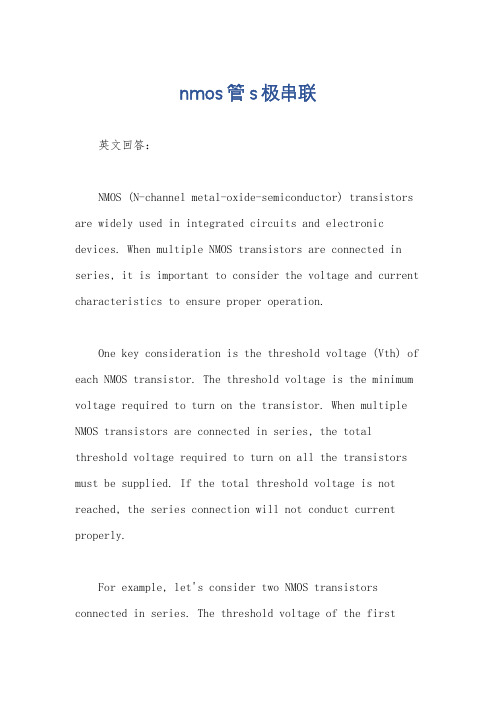
nmos管s极串联英文回答:NMOS (N-channel metal-oxide-semiconductor) transistors are widely used in integrated circuits and electronic devices. When multiple NMOS transistors are connected in series, it is important to consider the voltage and current characteristics to ensure proper operation.One key consideration is the threshold voltage (Vth) of each NMOS transistor. The threshold voltage is the minimum voltage required to turn on the transistor. When multiple NMOS transistors are connected in series, the total threshold voltage required to turn on all the transistors must be supplied. If the total threshold voltage is not reached, the series connection will not conduct current properly.For example, let's consider two NMOS transistors connected in series. The threshold voltage of the firsttransistor is 0.5V, and the threshold voltage of the second transistor is 0.7V. To turn on both transistors, a total threshold voltage of 1.2V is required. If the input voltage is only 1V, the second transistor will not turn on, and the series connection will not function as intended.Another consideration is the drain-source voltage (Vds) rating of each NMOS transistor. The drain-source voltage is the maximum voltage that can be applied across the transistor without causing damage. When multiple NMOS transistors are connected in series, the total drain-source voltage must not exceed the rating of any individual transistor. If the total drain-source voltage exceeds the rating, it can lead to breakdown and failure of the transistors.For example, let's consider two NMOS transistors with a Vds rating of 20V each. If the total drain-source voltage applied across the series connection is 30V, it will exceed the rating of each transistor, leading to potential damage.To avoid these issues, it is important to select NMOStransistors with compatible threshold voltages and drain-source voltage ratings when connecting them in series. Additionally, it is important to ensure that the input voltage is sufficient to turn on all the transistors in the series connection.中文回答:NMOS(N型金属氧化物半导体)晶体管广泛应用于集成电路和电子设备中。
硫原子单波长异常散射(s-sad)
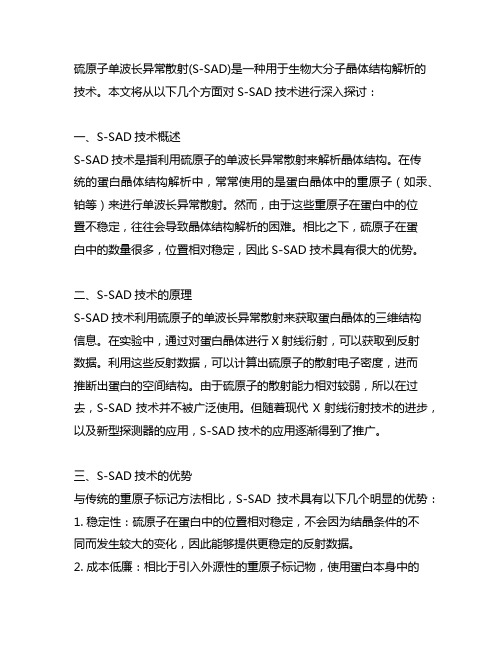
硫原子单波长异常散射(S-SAD)是一种用于生物大分子晶体结构解析的技术。
本文将从以下几个方面对S-SAD技术进行深入探讨:一、S-SAD技术概述S-SAD技术是指利用硫原子的单波长异常散射来解析晶体结构。
在传统的蛋白晶体结构解析中,常常使用的是蛋白晶体中的重原子(如汞、铂等)来进行单波长异常散射。
然而,由于这些重原子在蛋白中的位置不稳定,往往会导致晶体结构解析的困难。
相比之下,硫原子在蛋白中的数量很多,位置相对稳定,因此S-SAD技术具有很大的优势。
二、S-SAD技术的原理S-SAD技术利用硫原子的单波长异常散射来获取蛋白晶体的三维结构信息。
在实验中,通过对蛋白晶体进行X射线衍射,可以获取到反射数据。
利用这些反射数据,可以计算出硫原子的散射电子密度,进而推断出蛋白的空间结构。
由于硫原子的散射能力相对较弱,所以在过去,S-SAD技术并不被广泛使用。
但随着现代X射线衍射技术的进步,以及新型探测器的应用,S-SAD技术的应用逐渐得到了推广。
三、S-SAD技术的优势与传统的重原子标记方法相比,S-SAD技术具有以下几个明显的优势:1. 稳定性:硫原子在蛋白中的位置相对稳定,不会因为结晶条件的不同而发生较大的变化,因此能够提供更稳定的反射数据。
2. 成本低廉:相比于引入外源性的重原子标记物,使用蛋白本身中的硫原子进行结构分析成本更低。
3. 广泛适用性:几乎所有的蛋白质都含有硫原子,因此S-SAD技术适用范围广泛。
四、S-SAD技术的挑战虽然S-SAD技术具有很多优势,但在实际应用中也存在一些挑战,例如:1. 数据采集困难:由于硫原子的散射能力较弱,因此在实验中需要更长时间的数据采集。
2. 数据处理复杂:对硫原子的单波长异常散射数据处理相对复杂,需要更高级的数据处理技术和算法支持。
3. 分辨率限制:由于硫原子的散射能力较弱,因此S-SAD技术在分辨率上往往受到一定的限制。
五、S-SAD技术的应用前景尽管S-SAD技术在一些方面存在挑战,但随着X射线衍射技术的不断进步,S-SAD技术的应用前景依然十分广阔。
IUHET-374 NORDITA-9784P
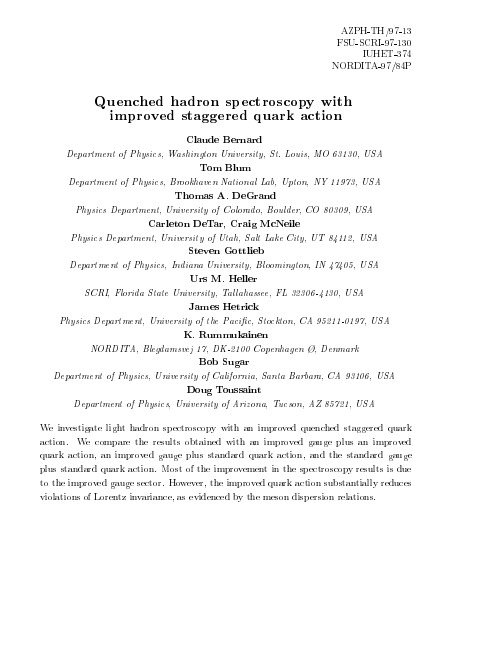
1 Introduction
The precision of numerical lattice QCD simulations with the standard lattice actions is constrained by the available computational resources. In order to keep the duration of the calculation within manageable bounds, one is forced to use lattice spacings a which may be too large to accurately describe the continuum physics. This problem has been addressed by the development of improved 1, 2, 3] and xed-point 4] actions. The promise of these actions is to yield good approximations to the continuum physics with relatively coarse lattice spacings. (For a recent review, see 5].) In the Symanzik improvement scheme 1, 2] the lattice action and elds are improved in powers of the lattice spacing a. This is achieved by introducing higher dimensional terms into the action. In the continuum limit, these terms are irrelevant, but at a nite cuto the coe cients of these terms can be tuned so that the discretization errors of spectral quantities are diminished. The most straightforward method to determine the coe cients is to expand the action in a Taylor series in a, and cancel the leading scaling violating terms order by order (tree-level improvement). This can be re ned by using perturbative analysis or non-perturbative numerical methods to determine the coe cients. In this paper, we study the improvement of the staggered (Kogut-Susskind) quark lattice QCD action with quenched spectroscopy calculations. The improvement is implemented by adding a third-nearest-neighbor term, rst proposed by Naik more than a decade ago 6]. Some of the preliminary results of this study have already been published in 7, 8]. The same improvement scheme has been applied to nonzero temperature calculations by Karsch et al. 9]. The gauge con gurations used in this study are generated with an O(a ) one-loop and tadpole-improved gauge action 2, 3]. Since our main goal is to investigate the e ects of the fermionic improvement, we compare the hadronic spectrum obtained with both the unimproved and improved fermion actions, using the same gauge con gurations. An excellent baseline for the evaluation of the improvement is provided by our extensive standard (non-improved) quenched Kogut-Susskind hadron spectroscopy calculation 10]. As opposed to Wilson fermions, the improvement of the staggered action has attracted relatively little attention. This is partly due to the formal complexity of the staggered formulation, partly to the fact that the standard Wilson fermions have an error O(a),
3B SCIENTIFIC PHYSICS 音频微波探头说明书
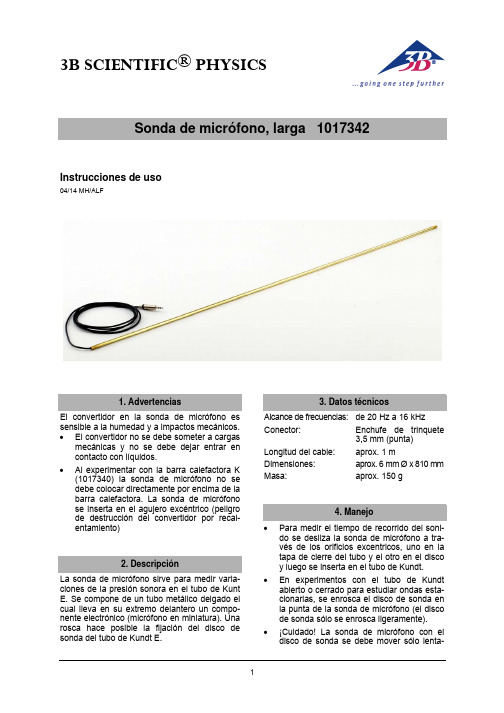
3B SCIENTIFIC ® PHYSICS1Sonda de micrófono, larga 1017342Instrucciones de uso04/14 MH/ALF1. AdvertenciasEl convertidor en la sonda de micrófono es sensible a la humedad y a impactos mecánicos. • El convertidor no se debe someter a cargasmecánicas y no se debe dejar entrar en contacto con líquidos. • Al experimentar con la barra calefactora K(1017340) la sonda de micrófono no se debe colocar directamente por encima de la barra calefactora. La sonda de micrófono se inserta en el agujero excéntrico (peligro de destrucción del convertidor por recal-entamiento)2. DescripciónLa sonda de micrófono sirve para medir varia-ciones de la presión sonora en el tubo de Kunt E. Se compone de un tubo metálico delgado el cual lleva en su extremo delantero un compo-nente electrónico (micrófono en miniatura). Una rosca hace posible la fijación del disco de sonda del tubo de Kundt E.3. Datos técnicosAlcance de frecuencias: de 20 Hz a 16 kHz Conector: Enchufe de trinquete3,5 mm (punta)Longitud del cable: aprox. 1 m Dimensiones: aprox. 6 mm Ø x 810 mm Masa: aprox. 150 g4. Manejo• Para medir el tiempo de recorrido del soni-do se desliza la sonda de micrófono a tra-vés de los orificios excentricos, uno en la tapa de cierre del tubo y el otro en el disco y luego se inserta en el tubo de Kundt. • En experimentos con el tubo de Kundtabierto o cerrado para estudiar ondas esta-cionarias, se enrosca el disco de sonda en la punta de la sonda de micrófono (el disco de sonda sólo se enrosca ligeramente). • ¡Cuidado! La sonda de micrófono con eldisco de sonda se debe mover sólo lenta-3B Scientific GmbH ▪ Rudorffweg 8 ▪ 21031 Hamburgo ▪ Alemania ▪ Nos reservamos el derecho a modificaciones técnicas© Copyright 2014 3B Scientific GmbHmente al insertarla en el tubo de Kundt (pe-ligro para el altavoz y el micrófono por compresión del aire). •En experimentos en los cuales sea necesa-rio utilizar la barra calefactora K (1017340) en el tubo de Kundt, la sonda no se debe colocar directamente encima del ele-mento calefactor .• Se conecta la sonda de micrófono con lacaja de micrófono.5. Aparatos adicionales recomendadosTubo de Kundt E 1017339 Caja de micrófono (230 V, 50/60 Hz) 1014520 resp. Caja de micrófono (115 V, 50/60 Hz) 1014521 Caja de impulsos K 1017341Contador de microsegundos (230 V, 50/60 Hz)1017333resp.Contador de microsegundos (115 V, 50/60 Hz)1017334 Sonda de micrófono, corta 4008308Barra calefactora K 10173406. Almacenamiento, Limpieza, Desecho • El aparato se almacena en un lugar limpio,seco y libre de polvo. • Antes de limpiar el aparato se desconectade la fuente alimentación.• Para limpiarlo se utiliza un trapo suavehúmedo. El convertidor no se debe someter a cargas mecánicas y no se debe dejar en-trar en contacto con líquidos. • El embalaje se desecha en los lugareslocales para reciclaje.• En caso de que elpropio aparato sedeba desechar como chatarra, no se debe deponer entre los desechos domésticosnormales. Se deben cumplir lasprescripciones localespara el desecho dechatarra eléctrica.Fig. 1Sonda de micrófono con el disco de sonda enroscado。
thespecialtopicofaminoacidextractionconstant分子生物学课件
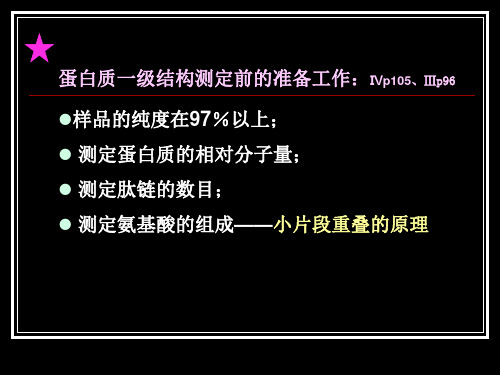
Lys-Leu-Phe-Pro-Val Lys-Val-Phe-Pro-Leu
Leu-Phe-Pro-Val- Lys Val-Phe-Pro-Leu-Lys
表1-1 氨基酸的pK’和pI值(pH)
氨基酸
pK'-COOH
注释 Rn≠ Pro Rn≠ Pro
Rn≠ Pro
Rn≠ Pro 热稳定 Rn≠ Pro
习 题 1: 由下列信息求八肽的序列。 (a)酸水解得Ala,Arg,Leu,Met,Phe,Thr,2Val (b)Sanger试剂处理得DNP-Ala。 (c)胰蛋白酶处理得Ala,Arg,Thr和Leu,Met, Phe,2 Val;当以Sanger试剂处理时分别得到 DNP-Ala和DNP-Val。 (d)溴化氰处理得Ala、Arg、高丝氨酸内酯、Thr、 2 Val和Leu、Phe;当用Sanger试剂处理时, 分别得DNP-Ala和DNP-Leu。
甘氨酸(Gly) 2.34 丙氨酸(Ala) 2.34 缬氨酸(Val) 2.32 亮氨酸(Leu) 2.36 异亮氨酸(Ile) 2.36
天冬氨酸(Asp) 2.09
天冬酰胺(Asn) 2.02
pK' -NH2
pKR
pI
9.60 9.69 9.62 9.60 9.68
9.82
8.80
5.95
6.02
例题详解
Sanger反应测定蛋白质N末端
RO
RO
O2N
F + H2N CH C
O2N
HN CH C
NO2 DNFB
H+ O2N
微波网络 S,Y,A参数
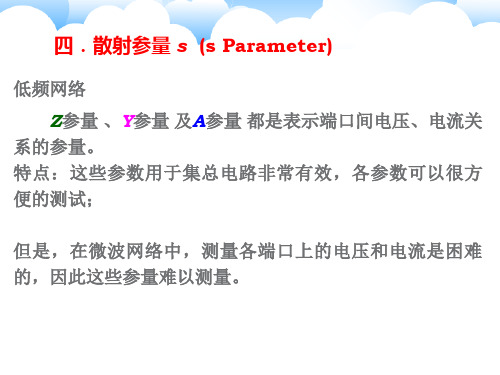
证 明 :
| S11 |2 | S21 |2 1 (1) 2 2 | S22 | | S12 | 1 (2) * * S S S (3) 21S 22 0 11 12
由 3 得 : S21
由1、3 得:
2
S11 S12 S22
e
j11
e
j12
S22 2 2 S12 由2得: S22 (1 ) 1 j j21 j22 2 e e e S22 | S11 || S22 |
[ ] + Hermite 符号, 表示共轭转置或转置共轭
3.N口散射参量 s (s Parameter)
物理意义:Sii 其它端口接匹配负载,i口的反射系数 Sij 其它端口接匹配负载, j 口到 i 口的传输 系数 注意:每一端口的散射参量都是在其他端口接匹配负载的 状态下定义的。 因此,对于图 5-2 所示的二端口网络,当端口(2)所接 负载 ZL Z02 时,端口(1)的反射系数不再等于 s11。 这种情况下,若令端口(1)的电压反射系数为 1,则由 散射参量的定义式,可求得 1 与负载反射系数 L 的关系。
后一项的实部显然等于0,于是可见
1 P ( aa* bb* ) 2
关系更加清晰:P=P入-P反
(1)物理意义是功率等于入射功率减去散射功率。
四.散射参量 s (s Parameter)
入射功率=各端口入射功率的和
1 P (aa* ) 2
1 P入 [ a ] [ a ] 2 1 1 * P入 ( a1 a1 )+ ( a2 a2* ) 2 2
a1 a2
或简写成
[b] = [s] [a] a2
a1
全谱直读电感耦合等离子体发射光谱法测定地球化学样品中的微量硫
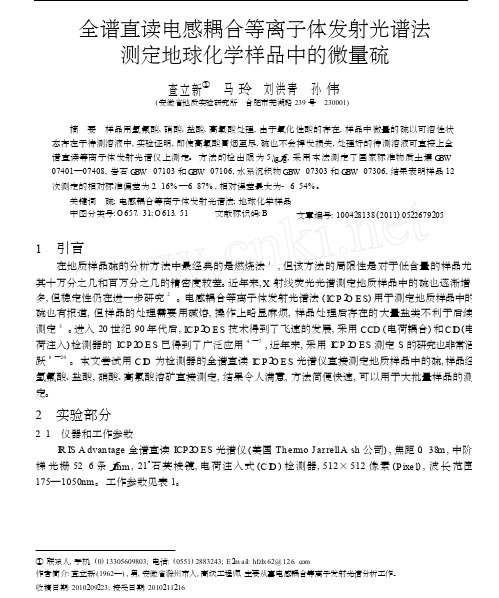
全谱直读电感耦合等离子体发射光谱法测定地球化学样品中的微量硫查立新①马玲刘洪青孙伟( 安徽省地质实验研究所合肥市芜湖路239 号230001)摘要样品用氢氟酸、硝酸、盐酸、高氯酸处理, 由于氧化性酸的存在, 样品中微量的硫以可溶性状态存在于待测溶液中, 实验证明, 即使高氯酸冒烟至尽, 硫也不会挥发损失, 处理好的待测溶液可直接上全谱直读等离子体发射光谱仪上测定。
方法的检出限为5Λgƒg, 采用本法测定了国家标准物质土壤G BW 07401—07408, 岩石G B W 07103 和G B W 07106, 水系沉积物GBW 07303 和G B W 07306, 结果表明样品12 次测定的相对标准偏差为2. 16% —6. 87% , 相对误差最大为- 6. 54%。
关键词硫; 电感耦合等离子体发射光谱法; 地球化学样品中图分类号: O 657. 31; O 613. 51 文献标识码: B文章编号: 100428138 (2011) 05226792051 引言在地质样品硫的分析方法中最经典的是燃烧法 1 , 但该方法的局限性是对于低含量的样品尤其十万分之几和百万分之几的精密度较差。
近年来, X 射线荧光光谱测定地质样品中的硫也逐渐增多, 但稳定性仍在进一步研究 2 。
电感耦合等离子体发射光谱法( IC P 2O E S) 用于测定地质样品中的硫也有报道, 但样品的处理需要用碱熔, 操作上略显麻烦, 样品处理后存在的大量盐类不利于后续测定 3 。
进入20 世纪90 年代后, IC P 2O E S 技术得到了飞速的发展, 采用CCD (电荷耦合) 和C I D(电荷注入) 检测器的IC P 2O E S 已得到了广泛应用 4 —7 , 近年来, 采用I C P 2O E S 测定S 的研究也非常活跃8 —20 。
本文尝试用C I D为检测器的全谱直读I C P 2O E S 光谱仪直接测定地质样品中的硫, 样品经氢氟酸、盐酸, 硝酸、高氯酸溶矿直接测定, 结果令人满意, 方法简便快速, 可以用于大批量样品的测定。
(英文)低阻抗InGa(Al)As隧道结长波长VCSEL
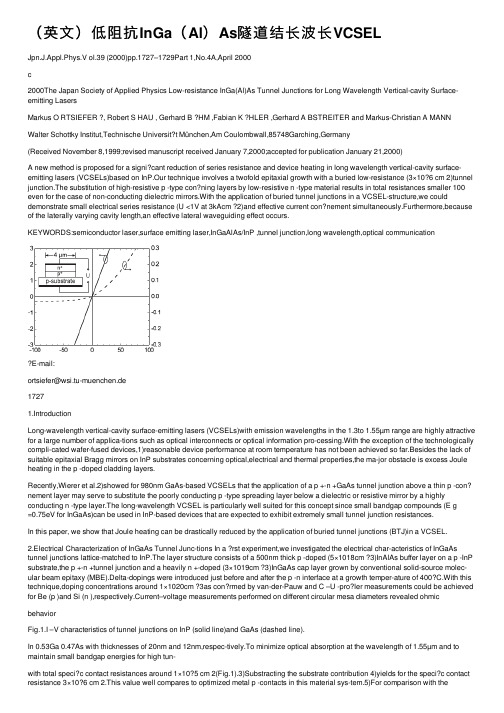
(英⽂)低阻抗InGa(Al)As隧道结长波长VCSELJpn.J.Appl.Phys.V ol.39 (2000)pp.1727–1729Part 1,No.4A,April 2000c2000The Japan Society of Applied Physics Low-resistance InGa(Al)As Tunnel Junctions for Long Wavelength Vertical-cavity Surface-emitting LasersMarkus O RTSIEFER ?, Robert S HAU , Gerhard B ?HM ,Fabian K ?HLER ,Gerhard A BSTREITER and Markus-Christian A MANN Walter Schottky Institut,Technische Universit?t München,Am Coulombwall,85748Garching,Germany(Received November 8,1999;revised manuscript received January 7,2000;accepted for publication January 21,2000)A new method is proposed for a signi?cant reduction of series resistance and device heating in long wavelength vertical-cavity surface-emitting lasers (VCSELs)based on InP.Our technique involves a twofold epitaxial growth with a buried low-resistance (3×10?6 cm 2)tunnel junction.The substitution of high-resistive p -type con?ning layers by low-resistive n -type material results in total resistances smaller 100 even for the case of non-conducting dielectric mirrors.With the application of buried tunnel junctions in a VCSEL-structure,we could demonstrate small electrical series resistance (U <1V at 3kAcm ?2)and effective current con?nement simultaneously.Furthermore,because of the laterally varying cavity length,an effective lateral waveguiding effect occurs.KEYWORDS:semiconductor laser,surface emitting laser,InGaAlAs/InP ,tunnel junction,long wavelength,optical communicationE-mail:*************************.de17271.IntroductionLong-wavelength vertical-cavity surface-emitting lasers (VCSELs)with emission wavelengths in the 1.3to 1.55µm range are highly attractive for a large number of applica-tions such as optical interconnects or optical information pro-cessing.With the exception of the technologically compli-cated wafer-fused devices,1)reasonable device performance at room temperature has not been achieved so far.Besides the lack of suitable epitaxial Bragg mirrors on InP substrates concerning optical,electrical and thermal properties,the ma-jor obstacle is excess Joule heating in the p -doped cladding layers.Recently,Wierer et al.2)showed for 980nm GaAs-based VCSELs that the application of a p +-n +GaAs tunnel junction above a thin p -con? nement layer may serve to substitute the poorly conducting p -type spreading layer below a dielectric or resistive mirror by a highly conducting n -type layer.The long-wavelength VCSEL is particularly well suited for this concept since small bandgap compounds (E g=0.75eV for InGaAs)can be used in InP-based devices that are expected to exhibit extremely small tunnel junction resistances.In this paper, we show that Joule heating can be drastically reduced by the application of buried tunnel junctions (BTJ)in a VCSEL.2.Electrical Characterization of InGaAs Tunnel Junc-tions In a ?rst experiment,we investigated the electrical char-acteristics of InGaAs tunnel junctions lattice-matched to InP.The layer structure consists of a 500nm thick p -doped (5×1018cm ?3)InAlAs buffer layer on a p -InP substrate,the p +-n +tunnel junction and a heavily n +-doped (3×1019cm ?3)InGaAs cap layer grown by conventional solid-source molec-ular beam epitaxy (MBE).Delta-dopings were introduced just before and after the p -n interface at a growth temper-ature of 400?C.With this technique,doping concentrations around 1×1020cm ?3as con?rmed by van-der-Pauw and C –U -pro?ler measurements could be achieved for Be (p )and Si (n ),respectively.Current–voltage measurements performed on different circular mesa diameters revealed ohmic behaviorFig.1.I –V characteristics of tunnel junctions on InP (solid line)and GaAs (dashed line).In 0.53Ga 0.47As with thicknesses of 20nm and 12nm,respec-tively.To minimize optical absorption at the wavelength of 1.55µm and to maintain small bandgap energies for high tun-with total speci?c contact resistances around 1×10?5 cm 2(Fig.1).3)Substracting the substrate contribution 4)yields for the speci?c contact resistance 3×10?6 cm 2.This value well compares to optimized metal p -contacts in this material sys-tem.5)For comparison with theAlGaAs/GaAs material sys-tem,Fig.1shows the measurements for geometrically identi-cal InP-based p +-n +-InGaAs and GaAs-based p +-n +-GaAs tunnel junctions revealing a non-ohmic,high-resistive behav-ior.3.Fabrication and Characterization of Buried TunnelJunctions In order to investigate the electrical performance of the BTJ alone,a simpli?ed non-lasing VCSEL-structure was made without Bragg mirrors as shown in Fig.2.In a ?rst epi-taxial run,n -type InAlAs (5×1017cm ?3),three compres-sively strained (1.6%)InGaAlAs-quantum wells (emission-wavelength 1.55µm)and p -type InAlAs (5×1017cm ?3)were grown by MBE on an exactly oriented (100)n -InP sub-strate.The structure was completed by the tunnel junction consisting of heavily doped p +-In 0.53Ga 0.40Al 0.07As and n +-D 0=22µm and D BTJ =0,representing the two marginal cases for the diameter of the tunnel junction,are shown in Fig.3.At a diode voltage of 0.9V ,for example,the current for D BTJ =D 0=22µm amounts 9mA compared to 0.0025mA in the latter case.The currentdensities,however,differ by a factor of about 3×103.Hence,even for tunnel junctions with very small diameter,the current ?ow is effectively restricted to the tunnel junction and leakage currents outside this region can completely be neglected.For a typical case with D BTJ =neling rates,p +-InGaAlAs with a bandgap energy of 0.83eV is used.On the other hand,negligible fundamental bandgap absorption occurs in n +-doped InGaAs due to a large Burstein shift.6)Positioning of the 32nm thick tunnel junction at a minimum of the optical intensity distribution in the VCSEL cavity keeps the transmission loss far below 10?3even for absorption coef?cients of the order of 1000cm ?1.The n +-layer and a part of the p +-layer were removed outside the BTJ in a dry-etching process using a mixture of methane,hydrogen and nitrogen.The second epitaxial run was done by a maskless regrowth with chemical beam epi-taxy (CBE),starting with an n -InP spreading layer with a thickness of 110nm and ending with a 60nm contact layer of heavily n +-doped (3×1019cm ?3)InGaAs.InP is used for regrowth because of its favourable thermal conductivity 7)of 0.67Wcm ?1K ?1.To suppress tunneling at the p +-n interface outside the BTJ,growth of InP starts with a doping concen-tration of 4×1017cm ?3which is increased to 4×1018cm ?3after a thickness of 10nm.This process results in an abrupt blocking p +-n junction with reverse bias in the etched regions and an ohmic p +-n +tunnel junction within the non-etched di-ameter D BTJ .Assuming constant current density j along the BTJ,the lateral voltage drop along the junction isU =ρd D BTJ /20I (r )dr 2πr =ρj D 2BTJ 16d (1)where I (r )=jr 2πis the total current ?owing into the BTJwithin radius r .ρand d denote the speci?c resistance and thickness,respectively.With ρ=10?3 cm,D BTJ =10µm,j =5kAcm ?2and d =100nm, U -values as low as 30mV can thus be achieved.Current–voltage curves for D BTJ =13µm and D 0=22µm,we measured a voltage of 1.18V at 5mA (≡3.7kAcm ?2)and a differential series resistance of R =60 ,indicating the expected low spreading layer resistance.The current con? nement is additionally con?rmed by the near-?eld pattern (Fig.4).According to theory,8)lateral waveguiding occurs in inho-mogeneously long cavities with an effective refractive index step given byn eff n eff = λ0(2)where λis the difference in resonant cavitywavelength.Fig.2.Schematic view of VCSEL test structure with the tunnel junction buried in n/doc/ac78c77a1711cc7931b71674.html teral current injection on the p -side is done by a low-resistive metal contact made on heavily doped n +-InGaAs.Fig.3.I –V curves of buried tunnel junctions of the VCSEL structure in Fig.2.Fig.4.Near-?eld pattern of the VCSEL structure in Fig.2.The central light spot indicates the aperture diameter of the buried tunnel junction D BTJ .1728Jpn.J.Appl.Phys.V ol.39 (2000)Pt.1,No.4A M.O RTSIEFER et al.AcknowledgementsThe authors wish to thank R.Meyer,G.Ebert,E.Sckopke,N.M?llenhoff and J.Grottenthaler for their assistance.This work has been supported by the Deutsche Forschungsgemein-schaft via Sonderforschungsbereich 348.1) D.I.Babi′c ,K.Streubel,R.P.Mirin,M.Margalit,J.E.Bowers,E.L.Hu,D.E.Mars,L.Yang and K.Carey:IEEE Photon.Technol.Lett.7(1995)1225.2)J.J.Wierer,P.W.Evans,N.Holonyak,Jr.and D.A.Kellogg:Appl.Phys.Lett.71(1997)3468.3)M.Arzberger,M.Lohner,G.B?hm and M.-C.Amann:to be published in Electron.Lett.4)G.Franz and M.-C.Amann:J.Electrochem.Soc.140(1993)847.5)M.-H.Park and L.C. Wang:J.Appl.Phys.81(1997)2720.6) D.G.Deppe,N.D.Gerrard,C.J.Pinzone,R.D.Dupuis and E.F.Schu-bert:Appl.Phys.Lett.56(1990)315.7)Landolt and B?rnstein:Semiconductors:Physics of Group IV Elements and III–V Compounds (Springer,Berlin,1982)V ol.III/17a p.571.8)G.R.Hadley,K.L.Lear,M.E.Warren,K.D.Choquette,J.W.Scott and S.W.Corzine:IEEE J. Quantum Electron.32(1996)607.4.ConclusionsInGa(Al)As tunnel junctions on InP revealed junction re-sistances of the order of 3×10?6 cm/doc/ac78c77a1711cc7931b71674.html teral removal of the tunnel junction layers and subsequent epitaxial re-growth results in a buried tunnel junction.The replacement of poorly conducting p -type spreading layers by highly con-ducting n -type material leads to ultra-low series resistances.By electrical and optical characterization we also found ef-fective current con?nement to the extent of the buried tun-nel junction.Furthermore,the varying cavity length is also expected to yield effective lateral index guiding.Employing this concept,the device performance of VCSELs may be sig-ni?cantly improved and the realization of high-performance long-wavelength VCSELs on InP seems feasible.For a typical λ0=1.55µm VCSEL with an effective cavity length of 2µm,a BTJ with 20nm thickness yields a 16nm blue-shift in cavity resonance corresponding to an effective index decrease of about 0.033which is comparable to the val-ues achieved by oxide-con?ned AlGaAs/GaAs devices in the short wavelength regime.Jpn.J.Appl.Phys.V ol.39 (2000)Pt.1,No.4A M.O RTSIEFER et al.1729。
通过改变S%(Au)探测器灵敏区厚度鉴别带电粒子的方法及应用研究
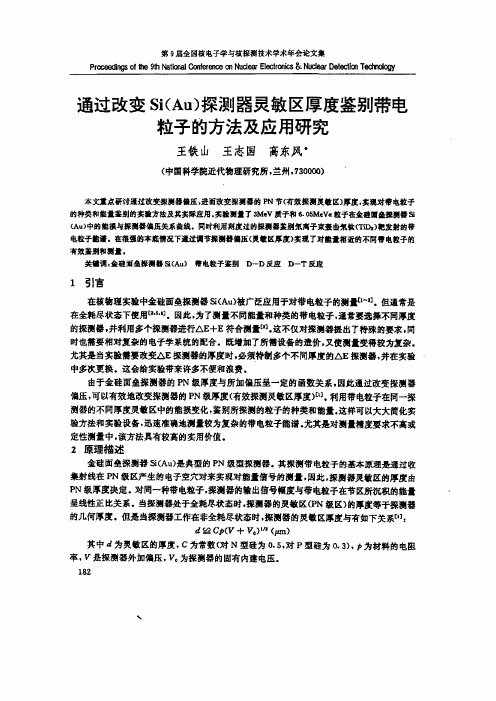
第9届全国核电子学与校探涮技术学术年会论文集Pr∞∞曲峰of船蛐№l酬co『I衙∞∞佣NIId鲥EIecl啪b&NlIcI哪Delecl咖Tec}mIO吖通过改变si(Au)探测器灵敏区厚度鉴别带电粒子的方法及应用研究王铁山王志国高东风’(中国科学院近代物理研究所。
兰州.730000)本文重点研讨通过改变探澍器僖压,进而改变探浏嚣的PN节(有效探涓夏t区)厚度。
宴现对带电粒子的种类和能量鉴别的实验方法及其实际应用.实验测量了3MeV质子和6.05M帆柱子在金硅Ⅲ蛊探铡器&(Au)中的能撮与探舅器信压关系曲线.同时利用刘度过的探捌嚣鉴别,lc离子柬蠢击氘钛(T司队)靶发射的带电粒子蠢谱.在很强的奉底情况下遗过调节探测嚣僖压(夏t区厚度)实现了对能量相近的不同带电粒子的有效鉴别和测量.关■调。
金硅面垒探测器&(Au)带电粒子鉴别D—D反应D—T反应1引言在棱物理实验中金硅面垒探溯器Si(Au)被广泛应用于对带电粒子的测量“’I】.但通常是在全耗尽状态下使用口6~.因此,为了测量不同能量和种类的带电粒子.通常要选择不同厚度的探测器t并利用多个探测器进行△E+E符合测量∞.这不仅对探测器提出丁特殊的要求。
同时也需要相对复杂的电子学系统的配合.既增加了所需设备的造价,又使测量变碍较为复杂.尤其是当实验需要改变△E探测器的厚度时,必须特制多个不同厚度的△E探测器,并在实验中多次更换.这会给实验带来许多不便和浪费.由于金硅面垒探测器的PN级厚度与所加偏压呈一定的函数关系.因此通过改变探测器偏压,可以有效地改变探测器的PN级厚度(有效探测灵敏区厚度)n】.利用带电粒子在同一探测器的不同厚度灵敏区中的能掼变化,鉴别所探测的粒子的种类和能量.这样可以大大简化实验方法和实验设备,迅速准确地测量较为复杂的带电粒子能谱.尤其是对测量精度要求不高或定性测量中,该方法具有较高的实用价值.2原理描述金硅面垒探测器si(Au)是典型的PN级型探测器.其探测带电粒子的基本原理是通过收集射线在PN级区产生的电子空穴对来实现对能量信号的测量,因此,探凋器灵敏区的厚度由PN级厚度决定.对同一种带电粒子,探测器的输出信号幅度与带电粒子在节区所沉积的能量呈线性正比关系.当探溯嚣处于全耗尽状态时,探测器的灵敏区(PN级区)的厚度等于探测器的几何厚度.但是当探测器工作在非全耗尽状态时,探溯器的灵敏区厚度与有如下关系山:d丝c’(y+K)1,l(肿1)其中d为灵敏区的厚度,c为常数(对N型硅为0.5,对P型硅为o.3),户为材料的电阻率.y是探测器外加偏压,砜为探浏器的固有内建电压.182当探测器的外加电压远远大于内建电压(y》K)时,上式可近似为:dS坌C(p矿)1n(弘m)此时,探测器的灵敏区厚度与外加电压的平方根呈线性正比关系.因此,实验中可以通过改变探测器的偏压有效地改变探测器灵敏区的厚度.由于不同的带电粒子所具有的质量数和电荷数不同,其在探澍器中的线性能量沉积具有明显的差别.因此,具有相同能量的不同种带电粒子在探测器中的射程有明显的差别.同样·具有不同能量的同种带电粒子在相同路径上的能量沉积也有明显差别.所以。
- 1、下载文档前请自行甄别文档内容的完整性,平台不提供额外的编辑、内容补充、找答案等附加服务。
- 2、"仅部分预览"的文档,不可在线预览部分如存在完整性等问题,可反馈申请退款(可完整预览的文档不适用该条件!)。
- 3、如文档侵犯您的权益,请联系客服反馈,我们会尽快为您处理(人工客服工作时间:9:00-18:30)。
III. Expressions & Patterns
A.
1. 观察某物以获取·· / 小心等待 ·· ·· to watch sth. for… / to watch for (L. 4) 他一直在等待着恰当的时机来表达对她的爱慕 之情。 He has been watching for the right moment to express his love for her.
5. resistant (L64) adj. offering resistance
Translation
防水的 防热的 防弹的 保守的人通常反对变化。
Key
water-resistant heat-resistant bullet-resistant
Conservative people are usually resistant to change.
经得起严峻的考验
抵挡住又一次进攻 耐穿 禁得住压力
3. enclose (L28)
[transitive] 1 to put something inside an envelope as well as a letter I am enclosing my résumé and three letters of reference. Please find enclosed… (=used in business letters to say that you are sending something with a letter) Please find enclosed an agenda for the meeting. I enclose herewith a cheque for 200 US dollars. 兹 附上… 2 [usually passive] to surround something, especially with a fence or wall, in order to make it separate
withstand
in addition to
fasten
occurrence
II. Chinese to English
地震预报 earthquake forecast
大批鱼群
地下水
large schools of fish
ground water
实验数据
重大财产损失
experimental data
同根词 Key
detection 察觉,侦查 detective 侦探
2. withstand (L18) v. bear; resist
Collocation
the storm severe tests withstand another attack hard wear pressure
顶住暴风雨
These precautions can make a great difference in saving lives and preventing the loss of homes. (L70) These precautions can be very important in saving lives and preventing the loss of homes.
Keep a fire extinguisher handy. (L42) Keep a fire extinguisher within your reach.
If an earthquake happens in a large city, many of the telephone lines within the city are likely to be down. (L56) down: not working e.g. The central heating system of this office building is down and several workers are repairing it right now.
Old to New Chinese to English Word Using
I. Old to New
notice or discover
increase, grow detect wax (wax and wane)
bear
apart from secure or fix (sth.) firmly a happening
A sensible arrangement is to have all of the members of the family call to check in with a friend or relative who lives more than a hundred miles away. (Para 6) A reasonable and practical arrangement is that every member of the family should call a friend or relative who lives more than a hundred miles away to report their situation. Check in: call someone to tell them that you are safe or where you are.
III. Expressions & Patterns
2. 抵御地震的力量 to withstand the power of earthquakes (L. 19) 经受不住艰难困苦 考验的友谊不可能 长久。 Any friendship that can’t withstand the trial of hardship is not likely to last long.
III. Expressions & Patterns
Back
5. 为··的可能性作好防备 ·· ·· to prepare for the possibility of … (L. 30) 大学生活的目的就是使我们为未来可能出现 的挑战做好准备。 The purpose of college life is to prepare us for the possibility of future challenges.
attach importance/significance etc to sth People attach too much importance to economic forecasts.
Check in (phrasal verb) 1. if you check in or are checked in at a hotel or airport, you go to the desk and report that you have arrived You need to check in two hours before the flight. check in at He checked in at the Olympic Hotel. check somebody ↔ in Airline employees were checking in passengers.
Steel seems to be the best material, but not if it is welded to form a rigid structure. (L19) Steel seems to be the best material. But it is not the best material if it is welded to form a rigid structure.
III. Expressions & Patterns
4. 把某物插入··ຫໍສະໝຸດ 中/中间 ··· to insert sth. in / into / between (L. 25) 麦氏公司(Maxwell House)在一家报纸上曾刊登 了一则广告:滴滴香浓,意犹未尽。 The Maxwell House inserted in a newspaper an advertisement : Good to the last drop.
the great destruction of property
雨林的毁坏 毕竟;别忘了 倒塌的建筑物 横梁 垂直支柱 水泥柱
the destruction of rainforests after all
falling buildings
horizontal beams vertical support columns concrete pillar knee joints
to attach sth. to … (L. 32)
Attach a recent photograph to your application form.
be attached to sb/sth to like someone or something very much, because you have known them or had them for a long time It's easy to become attached to the children you work with.
备用电池
extra battery
地震救生储备
急救用品 便携式露营灶 玻璃碎片 明智的安排
earthquake survival supplies
first-aid supplies
